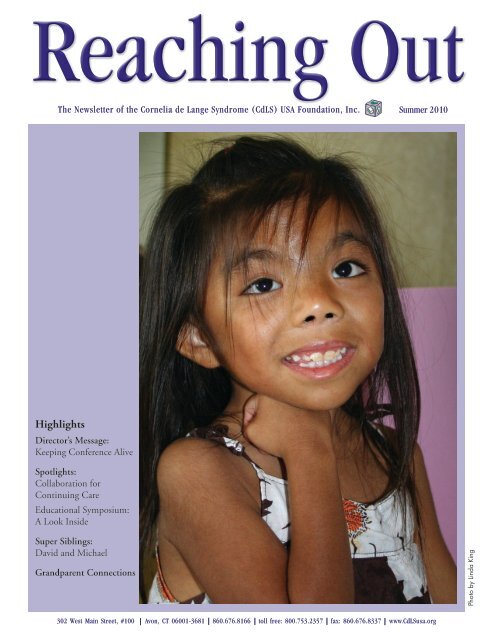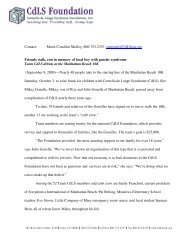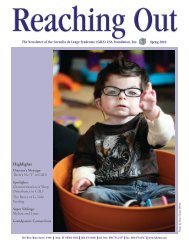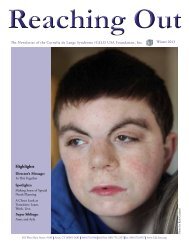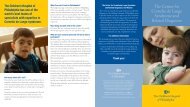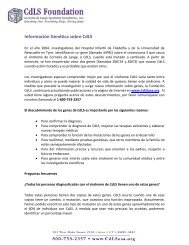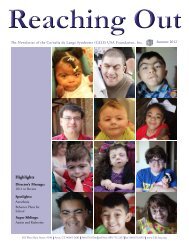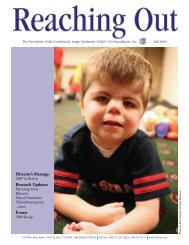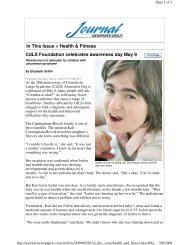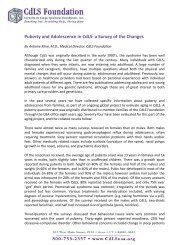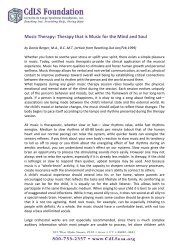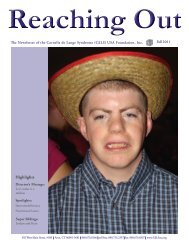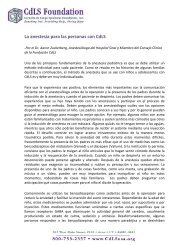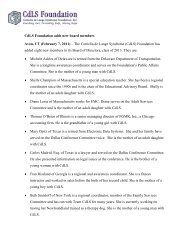Summer 2010 - CdLS
Summer 2010 - CdLS
Summer 2010 - CdLS
Create successful ePaper yourself
Turn your PDF publications into a flip-book with our unique Google optimized e-Paper software.
Reaching OutThe Newsletter of the Cornelia de Lange Syndrome (<strong>CdLS</strong>) USA Foundation, Inc.<strong>Summer</strong> <strong>2010</strong>HighlightsDirector’s Message:Keeping Conference AliveSpotlights:Collaboration forContinuing CareEducational Symposium:A Look InsideSuper Siblings:David and MichaelGrandparent ConnectionsPhoto by Linda King302 West Main Street, #100 Avon, CT 06001-3681 860.676.8166 toll free: 800.753.2357 fax: 860.676.8337 www.<strong>CdLS</strong>usa.org
Di r e c t o r’s MessageLiana and Brennen, posing for a photo-op at the<strong>2010</strong> Conference Banquet.Keeping Conference AliveOn my flight home from Dallas following the family conference, I had fourhours to catch my breath and replay in my head the previous days. I saw oldfriends, new faces, had lots of laughs and a few tears as I reminisced.At the beginning of conference, I told a room full of people that conferencewas going to change their lives. I have no doubt that it changed many,especially first-time attendees. Out of 128 families coming to conference, 40percent were first-timers. Here are some examples of what we’ve been hearingfrom these families:Being there with all the families felt so natural. It was more of a family reunionthan anything. Those few days were full of laughter and tears but in the end Iwalked away feeling so much better than I had …I was hesitant to go, but I was blown away once I was there. I know now that I’ll never miss another one.We were never alone. If you walked up to a group of families, people were rarely holding their own kids. It was such a lovingenvironment and I really miss my new friends.When I hear things like that, it reminds me how important our biennial conference is. For families, it’s not just threedays of workshops and consultations, it’s staying up late in the hotel lobby, sharing, laughing and supporting each otherwhile passing babies and toddlers around from lap to lap.The Foundation is committed to ensuring that conference continues. That’s why we’ve launchedthe 21 st Century Conference Fund—a restricted fund to ensure that families will continue tolearn, share and make memories in the future.To endow this fund, the <strong>CdLS</strong> Foundation will need $2 million. It won’t happen overnight. It’lltake slow and steady steps to get there, but we’re on our way. By conference, five families hadcommitted $1,000 each. During conference, another $5,000 was pledged. If we can continuethat momentum, we’ll keep chipping away at that big scary number, making it smaller and less intimidating.So please join in this worthwhile effort and contribute to the 21 st Century Conference Fund. No amount is too small.You’ll be rewarded with a warm, fuzzy feeling, and if you pledge $1,000 or more, you’ll be a part of our founding familiesand receive a commemorative plaque.Please contact me at director@<strong>CdLS</strong>usa.org or 800-753-2357.56Closer Look: Mapping aPlan for your Child’s FutureEducational Symposium:A Look InsideIn This Issue4 Collaboration for Continuing Care: 8 The Experience of ConferenceRecap and Next StepsSuper Siblings: David and Michael7 Closer Look: Educational andTherapeutic Experiences of Children13 Fundraising Eventswith <strong>CdLS</strong>1011Grandparent ConnectionsSincerely,Liana Garcia-Fresher, R.D., M.S.Executive Directordirector@<strong>CdLS</strong>usa.orgReaching Out2www.<strong>CdLS</strong>usa.org
Th e Fo u r t h <strong>CdLS</strong> Scientific Sy m p o s i um :Im p r o v i n g Un d e r s ta n d i n g o f <strong>CdLS</strong>By Dale Dorsett, Ph.D., <strong>CdLS</strong> Foundation Research Council Chair; Professor, SaintLouis (MO) University School of MedicineThe Fourth <strong>CdLS</strong> Foundation ScientificSymposium, held in Dallas, TX, June 24, revealedhow far we’ve come since the first <strong>CdLS</strong> gene wasdiscovered in 2004. It also illustrated how far westill need to go.On the clinical front, presentations included theemerging evidence for premature aging, a highincidence of sinusitis, malocclusion (misalignmentof teeth) and thrombocytopenia (low bloodplatelets), and prevalence of sleep disorderedbreathing. Although further studies are needed to verify some of these, they allhave clinical implications for care.Dr. Laird Jackson, the former Medical Director of the Foundation, reported onhis “Causes of Death Study”, revealing a strong need for a <strong>CdLS</strong> patient registryto allow better investigation of causes of death and all other clinical aspects of<strong>CdLS</strong>.An emerging theme was the high prevalence of autism spectrum disorder in<strong>CdLS</strong>—becoming more severe at puberty—as reported by multiple investigators.Parental stress was also discussed, revealing parenting stress is much higher with<strong>CdLS</strong> than with Down Syndrome. This is thought to be due to the more challengingbehavior and low levels of pro-social behavior in children with <strong>CdLS</strong>.A dental study looking at anesthesia revealed that 80 percent of individuals with<strong>CdLS</strong> had an adverse reaction to Versed (Midazolam) compared to 28 percent ofthose on other agents with an adverse post-operative event. And on the prenataldiagnosis front, studies show that a combination of ultrasound, growth restriction,and maternal serum markers can provide strong evidence for <strong>CdLS</strong> in utero,important in genetic counseling.On the basic science side, rapid progress was reported since the first realizationthat <strong>CdLS</strong> is caused by molecular disturbances in the proteins involved in sisterchromatid cohesion, a fundamental process ensuring proper inheritance of geneticinformation every time a cell divides.Changes in the genes NIPBL, SMC1A and SMC3 have been found in <strong>CdLS</strong>—proteins from these genes form the cohesin complex and other genes are continuingto be investigated. Model organism studies in yeast, fruit flies, zebrafish, and micehave revealed that the genetic changes that cause <strong>CdLS</strong> affect development byregulating gene expression and not chromosome inheritance.Zebrafish work has showed that cohesin proteins are a key regulator of cellproliferation and growth and might contribute to the slow growth and small sizein <strong>CdLS</strong>. Studies in zebrafish and mice have revealed numerous changes in geneexpression, particularly in the developmental pathways of the heart and brain.1-800-753-2357continued on page 6<strong>CdLS</strong> FoundationCornelia de Lange Syndrome Foundation, Inc.Reaching Out, Providing Help, Giving HopeReaching OutPublished Since 1977(ISSN 1097-3052)Cornelia de Lange SyndromeFoundation, Inc.Incorporated December 1981302 West Main Street, #100Avon, CT 06001800.753.2357, 860.676.8166fax: 860.676.8337email: info@<strong>CdLS</strong>usa.orgwww.<strong>CdLS</strong>usa.orgBoard of DirectorsPresident.. . . . . . . . . . . . . David Fowler, MAVi c e President .. . . . . Glenn Dixon, Esq., NCVi c e President .. . . . . . . . . David Viland, MNTr e a s u r e r .. . . . . . . . . . . . Paul Patitucci, PADi r e c t o r s. . . Eileen Ahearn,M.D., Ph.D., WI. . . . . . . . . . . . . . . . . . . . . Garth Black, PA. . . . . . . . . . . . . . Robert Boneberg, Esq., NJ. . . . Kari Cunningham-Rosvik, A.P.R.N., WA. . . . . . . . . . . . . . .Dale Dorsett, Ph.D., MO. . . . . . . . . . . . . . Elizabeth Fouts,Ph.D., NH. . . . . . . . . . . . . . . . . . . . David Harvey, GA. . . . . . . . . . . . . . . . . . . Penny Ketchem, PA. . . . . . . . . . . . . . . . . . . Marc Needlman, ILPROFESSIONAL STAFFEXECUTIVE DIRECTORLiana Garcia-Fresher, R.D., M.SMEDICAL DIRECTORAntonie Kline, M.D.ASSISTANT EXECUTIVE DIRECTORMarie Concklin-MalloyCOMMUNICATIONS COORDINATORAlexi DaleneDEVELOPMENT COORDINATORGail SpeersFAMILY SERVICE MANAGERDeirdre Summa, M.S.W.FAMILY SERVICE COORDINATORSLynn Audette, M.S.W.Janette Peracchio, M.Ed.FINANCE MANAGERKelly BrownINFORMATION COORDINATORBarbara KoontzAll information contained herein is for the reader’spersonal interest. Articles on treatments, medications,or procedures, etc. are not guides for selftreatment.Questions should be discussed with yourdoctor or other appropriate professionals.3 Su m m e r <strong>2010</strong>
Co l l a b o r at i o n f o r Co n t i n u i n g Ca r e i n t o Ad u lt h o o d Wo r k s h o pBy Linda Blumkin, Ad Hoc Transition CommitteeThe conference workshop Collaboration for ContinuingCare featured presentations by three mildly affected adultswith <strong>CdLS</strong> and three parents of more involved individuals.Each shared his or her experiences with transitioning intoadult life—or transitioning their child—and describedservices used to facilitate the transition.Rachel, presenting at theworkshopA variety of living arrangementswere described, including adultsin their own apartments (withsupport services ranging fromminimal assistance a few hoursper week to 24/7 staff ), livingwith parents or living in a stateresidential center with one-ononecare. The panel illustrated thediversity of abilities and needsof individuals with <strong>CdLS</strong> andtaught that even more severelyaffected individuals (includingthose with behavioral issues) can, with appropriate support,successfully live and work in the community.Accomplishments of thethree mildly affected adultpanelists include successfullyadvocating to strike the word“retarded” from the name ofthe state agency serving thedevelopmentally disabledin Massachusetts, travelingwith friends to states as far asAlaska and Hawaii, workingRachel and Tim, presenters atthe workshopat meaningful jobs for pay and as volunteers in service toothers, attending college, and working with the Foundationas an awareness coordinator and Family Services Committeemember.Also discussed at the workshop were results from theFoundation’s survey about transition and adult servicesissues. It served as a springboard for discussion abouthow the Foundation can help develop best practices fortransitioning children with <strong>CdLS</strong> into adulthood andserving the needs of adults with <strong>CdLS</strong> over their lifespan.Highlights of the survey results include:• Sixty percent of individuals over age 22 live at homewith their parents, seven percent live in their own homes(with or without support services), seven percent livein state developmental centers or intermediate carefacilities, and the remainder live in other settings inthe community (primarily group homes).• Respondents reported difficulty in accessing adultservices because of the general scarcity of servicesin their area, because of behavior issues (includingaggression, anxiety and self-injurious behaviors), andbecause of the difficulty to meet medical needs of theperson with <strong>CdLS</strong> (including communication, feedingand mobility/orthopedic issues).• The transition to adult life is emotionally difficult formany individuals with <strong>CdLS</strong>, especially initially, withsome facing increased behavioral challenges, increasedanxiety or increased low mood or depression.• Transition is also emotionally difficult for manyparents, other family members or caregivers. Theyreport stress because of concern about financial issues,guilt about placing the person with <strong>CdLS</strong>, and lack ofappropriate services and guidance.Many excellent suggestions for future action by theFoundation were contributed by the attendees at thesession. These included developing a chronological guidefor preparing for transition and accessing adult services(what to do when); providing links to resources; compilinga registry of individuals with <strong>CdLS</strong> including informationabout their schools and living arrangements; preparing aFoundation position paper on transition and adult serviceneeds of teens and adults with <strong>CdLS</strong> for families to give toschools and agencies in support of requests for the servicesthey need; and fostering mentoring and communicationabout transition and adult services.The Foundation welcomes your suggestions as well,please call contact Liana at 800-753-2357 or director@<strong>CdLS</strong>usa.org.Reaching Out4www.<strong>CdLS</strong>usa.org
Mapping a Pl a n f o r y o u r Ch i l d’s Fu t u r eBy Janette Peracchio, M.Ed., <strong>CdLS</strong> Foundation Family Service Coordinator“Where do we begin?” is what I hear from parents whentheir child with <strong>CdLS</strong> reaches his or her teen years. Whenasked what their plans are for their child after high school,they often say they want the same type of life for him orher as any typical young adult. This includes working orvolunteering, spending times with friends, and having asafe and happy life. However, most parents and guardiansare at a loss for how to make these plans happen.Every student in a public education program has the rightto a transition plan made at the Individual EducationProgram (IEP) meeting when they turn 16 years old. Thefederal Individuals with Disabilities Education Act (IDEA)mandates that the plan be attached to the IEP and updatedat each meeting until the student graduates.If the child is able, she or he may be present at each IEPmeeting to make choices about future plans. There areseveral programs used by schools and agencies to guideindividuals and families during this important planningprocess. Sometimes a teacher or an agency worker leads thegroup through the planning; other groups hire a facilitatorfamiliar with the planning tool.The planning tools may have different names, such asMcGill Action Planning System (MAPS), COACH orPerson-Centered Planning, but they all have the samevision: to plan for the family and young adult’s future bybuilding partnerships and supporting choices. The planningstage can include several components for discussion: furthereducation or training programs, long-term care plans,transportation, health care, safety, recreation, financialneed, who is in the circle of support, companionship, andhaving a purposeful life. A good plan also takes into accountthe following:• Ongoing planning involving the consumer, the family,service coordinator from the state agency (e.g., stateDept. of Developmental Services), and others on theplanning team.• The team values the person’s choices andpartnerships that support self-determination andinterdependence.• Adults are supported in natural settings in their localcommunities, with opportunities to live in their ownhomes, have meaningful activities, and to participatein the life of their communities.1-800-753-2357• There is a high level of cooperation and a sense ofpartnership among all people on the planning team toovercome barriers and work through concerns.• The complexities of providing services and supportsto individuals and families require coordination andcooperation between governmental and communityagencies so there are no gaps in the provision of servicesor support.• The plan is based on the individual’s strengths,capabilities, preferences, lifestyle, and culturalbackground.• The focus is on the consumer and family with teammembers who are consultants or advisors helping theindividual achieve his/her preferred future.• Natural supports are personal relationships andassociations that are developed in the community, thatenhance the quality and security of life for the consumer.These include friendships in the neighborhoodand community, associations with fellow students,coworkers, club memberships, joining organizations,and civic activities of interest.Navigating and making a plan for a young adult is nevereasy, but there’s help available in every state. Contact yourchild’s caseworker or teacher to get help making a map foryour child’s future.Janette can be reached at 800-753-2357 or familyservice@<strong>CdLS</strong>usa.org.Helpful Websiteswww.circleofinclusion.orgwww.wrightslaw.comwww.education.com5 Su m m e r <strong>2010</strong>
Ed u c at i o n a l Sy m p o s i um : A Lo o k In s i d eBy Shelly Champion, M.Ed., Educational Advisory GroupThe first-ever <strong>CdLS</strong>Educational Symposium tookplace preceding the Corneliade Lange Syndrome (<strong>CdLS</strong>)Foundation National FamilyConference in Dallas thissummer. The symposiumwas held concurrently withthe fourth National <strong>CdLS</strong>Scientific Symposium.Topics covered during theE d u c a t i o n a l Sy m p o s i um Shelly Championincluded feeding , physical therapy and behavioralmanagement, as well as survey results regarding supportneeds of adult siblings of individuals with <strong>CdLS</strong>,educational and therapeutic experiences of individuals with<strong>CdLS</strong>, and a study exploring current parent perspectivesof the support group experience. Some highlights arementioned belowCheri Carrico, Ph.D, C.C.C.-S.L.P., discussed the relationof feeding issues and speech for individuals with <strong>CdLS</strong>. Astudy of individuals with <strong>CdLS</strong> concluded the prevalenceof feeding issues and a history of feeding behaviors suchas choking, coughing, gagging, vomiting, and spittingfood out at meal times; oral defensiveness; refusal to feedorally; and a history of tube feeding. Carrico suggested thatoral stimulation be provided as early as possible—even tochildren who are tube-fed—and that feeding should occurin a comfortable, friendly environment. (Please note thattechniques to improve oral feeding ability vary. You shouldalways consult with your doctor prior to attempting any feedingtherapies.)Amy Metrena, M.S.P.T., presented information onconditions that require physical therapy and recommendedsome adaptive equipment to promote proper alignment andacquisition of motor skills. Marco Grados, M.D., M.P.H.,discussed the behavioral profile and management in childrenwith <strong>CdLS</strong>. Grados said use of behavior modificationtechniques is paramount in managing difficult behaviors inchildren with <strong>CdLS</strong>, while the use of medication is helpfulbut often ancillary.Veronique Weinstein, M.S., presented results of her surveySupport Needs of Adult Siblings of Individuals with <strong>CdLS</strong>.Respondents explained that having a sibling with <strong>CdLS</strong>increased their awareness of others’ needs, as well as theirReaching Out6tolerance, resilience, patience, and empathy, and helpedthem develop coping skills and proficiencies.The Foundation, as well as members of EAG and theProfessional Development Committee, is committed toincreasing its ability to serve the <strong>CdLS</strong> Foundation families.If you have any questions regarding any topics discussed orother concerns, contact the Foundation and speak with anyof our Family Service Coordinators.Improving Understanding of <strong>CdLS</strong>continued from page 3Some of the changes appear to be responsible for low bodyfat. Both models will be important for understanding themolecular and developmental basis of <strong>CdLS</strong> in the future.Studies in baker’s yeast have also found effects on geneexpression and positioning of genes in the nucleus.Dr. Jinglan Liu, the first <strong>CdLS</strong> Foundation PostdoctoralFellow, reported that many genes are dysregulated incells from individuals with <strong>CdLS</strong> and this pattern ofdysregulation is consistent enough to diagnose <strong>CdLS</strong>–indicating the possibility for a new diagnostic test.Finally and perhaps most exciting, human skin fibroblastcells from individuals with <strong>CdLS</strong> have been able to begenetically reversed to make pluripotent cells that can thenbe re-differentiated into a number of different cell typesincluding neurons and heart muscle cells. This will providea very important tool for investigating why developmentand differentiation are altered in <strong>CdLS</strong> and testing potentialnew therapeutic methods, including drug screens. Becausethese “pluripotent stem” cells are derived from skin samplesand not embryos, they avoid the ethical issues associatedwith embryonic stem cells.The Scientific Symposium provided an importantopportunity for basic and clinical scientists to share theirrapid and exciting progress. The meeting not only attractedscientists and medical professionals from around thecountry but also investigators from New Zealand and Japan,enhancing collaborative efforts between basic and clinicalscientists around the world.The breadth and quality of the research that was presentedholds real promise to improve the understanding of <strong>CdLS</strong>and improve the lives of individuals with <strong>CdLS</strong> and theirfamilies.www.<strong>CdLS</strong>usa.org
Ed u c at i o n a l a n d Th e r a p e u t i c Experiences o f Ch i l d r e n w i t h <strong>CdLS</strong>By Mary Beth Bruder, Ph.D., and Jessica Sims, M.Ed., University of Connecticut A.J. Pappanikou Center for Excellence inDevelopmental DisabilitesThe Cornelia de Lange Syndrome (<strong>CdLS</strong>) Foundation andthe University of Connecticut A. J. Pappanikou Centerfor Excellence in Developmental Disabilities developed afollow-up survey in the fall of 2009 to assess the educationaland therapeutic experiences of children with <strong>CdLS</strong> andtheir families. The goal was to better understand thesupport and services this population is receiving and usethe information to improve services.The survey was divided into five age groups (0-2;3-5; 6-13; 14-21 in school; and 14-21 not in school) with questions ineach group related to therapies andservices, provider communication,educational settings and programming,care coordination, and friendships.One hundred and fifty-eight peopleparticipated in the survey; of those, 125were considered complete and used inanalyses. Participants represented 34 statesand Canada, with the majority being marriedmothers with at least a two-year collegedegree. Child characteristics were reported asfollows: 56 percent female, 85 percent white,14 percent aged 0-2 years, 20 percent aged 3-5years, 34 percent aged 6-13 years, and 32 percent aged 14-21years. Parents reported the majority of their children to bein good or very good health and rated their functioning asneeding some assistance.Results related to the therapies/services that children andfamilies are receiving indicate a wide variety of services. Themost common therapies/services children across all agegroups received were speech-language therapy, occupationaltherapy, physical therapy, and special instruction. Oralmotortherapy was also selected frequently for children0-5 years old. Other services children and familiesreceived include behavior management, nursing, sensoryintegration, and hippotherapy (horseback riding). Naturalenvironments such as the home or preschool was wherethe majority of young children received therapy/services.A commonality for children across all age groups was toreceive therapy/services in a one-on-one setting, though anumber of children aged 14-21 received therapy/servicesin a group setting.The results related to educational programming indicatesome possible areas for improvement. For example, themajority of families were not satisfied with the transitionprocess and felt that their child was not prepared, nor wasthere a plan in place. In addition, the majority of students( a g e d 6-21) spent half their time or less in a regularclassroom setting.On the positive side, families reported a varietyof adaptations and modifications being usedwith their child. Families of children aged0-2 most frequently reported the use ofsign language. Families of children aged3-21 most frequently reported the use ofa communication notebook, modifiedcurriculum, sign language, an aide, and apicture communication system.For the children aged 14-21 who wereno longer in school, results indicatedareas for additional research. All ofthese children lived at home withtheir families, and less than one-third had any typeof employment. It was also indicated that many of thesechildren did not participate in any type of activities in thecommunity, nor did they attend social gatherings. Moreresearch is needed to understand the needs of this agegroup and ways to facilitate independence and communityintegration.Overall, the survey has provided a good baseline ofinformation that can be used to investigate furthertherapeutic and educational experiences of children with<strong>CdLS</strong> and their families. It will be especially important tocontinue research to understand the appropriate inclusionof children with <strong>CdLS</strong> into school and community life.1-800-753-23577 Su m m e r <strong>2010</strong>
Reaching Out8www.<strong>CdLS</strong>usa.org
1-800-753-23579 Sp r i n g <strong>2010</strong>
Su p e r Si b l i n g s: Dav i d a n d Mi c h a e lDavid and his brotherMichael, an adult with <strong>CdLS</strong>,have always had an extremelyclose connection. Since theywere young, David and hisfriends have included Mikein their activities, and as theyDavid and Michaelgot older, the brothers’ bondonly got stronger. “As I grewolder, Mike grew “younger” mentally, and I became moreaware of his needs and how to care for him,” says David.“When we did things together, I made sure that it wassomething he would enjoy doing. We have a very strongrelationship now.”David and Mike still love spending time together, andevery time David travels back home to Western NewYork, they make time to do the things together thatthey both enjoy. “Mike loves to go to Wal-Mart to buystickers. Each time I’m home, this is one of our trips andsince Mike loves ice cream, that’s one of our trips too.It doesn’t take a lot to make Mike happy,” says David, aschool teacher in Maryland.Although life with <strong>CdLS</strong> has been at times challengingfor his family, it has also brought them closer together.It has allowed them to continually learn from theexperiences they’ve had with Mike, and share thoseexperiences with extended family members and friends.“Mike is accepted by our entire family and friends,” saysDavid. “Mike brings laughter and enjoyment to ourfamily. He is always the life of the party and keeps ourfamily young,” says David. “I feel that our entire familyhas learned so much from Mike about what he can doand not what his limitations are. They have become moreaware of other people with special needs.”David has been an active member of Mike’s life as well asother individuals with <strong>CdLS</strong>. He has devoted his time tolearning more about <strong>CdLS</strong> by attending and volunteeringat conferences, meeting other families affected by <strong>CdLS</strong>,and by getting constant updates from his parents onhow Mike is doing. David is a stand-by guardian to Mikeand wants to be as informed as he can be when he takesover this role. “I always feel it’s important for me to beinvolved with Mike because I need to make sure thatMike has what he needs. When the time comes for meto become Mike’s guardian, I’ll be well informed on howthings concerning Mike are. I am, and will continue tobe, an advocate for him.”WELCOME NEW FAMILIESArizonaBlair and Sydneyand daughter Cambria,born March 30, <strong>2010</strong>IndianaKatie and Chrisand daughter Coleena,born March 17, 2008New MexicoEvanthia and Dannyand son Sebastian,born December 23, 2004UtahStephanie and Tupakkand daughter Siena,born September 1, 2007ArkansasMegan and Kyleand son Kirk,born May 19, <strong>2010</strong>CaliforniaTraci and son Jacob,born March 22, <strong>2010</strong>MassachusettsLeeann anddaughter Destiny,born July 26, 2009MississippiSusannah and Jonathanand daughter Anna,born May 9, <strong>2010</strong>TexasValerie and daughter Alyssa,born August 6, 2009Myra and daughter Aubree,born November 1, 2009Amber and son Sean,born September 8, 2004Sara and daughter Lucy,born December 26, 1998WisconsinCrystal and Shannonand son Landon,born December 6, 2009Reaching Out10www.<strong>CdLS</strong>usa.org
Gr a n d pa r e n t Co n n e c t i o n sConference Connects GrandparentsThis year’s conference provided grandparents of individualswith <strong>CdLS</strong> opportunities to meet one another, share stories,understand more about <strong>CdLS</strong>, and learn new ways to helptheir children and grandchildren.At the Foundation’s request, many grandparents wrote abouttheir experiences with <strong>CdLS</strong>. Several shared advice, whileothers wrote about how their grandchildren changed theirlives or what it was like the first time they heard “<strong>CdLS</strong>.”Izzy’s grandmother, Betty, shares her story below.– Izabelle –Grandparents Betty and Jim withgranddaughter Izabelle1-800-753-2357The day my granddaughterwas born, we knewsomething was terriblywrong. She had so manycomplications we had littlehope that she would survive24 hours. My husband and Iboth held our fears in-checkuntil we were alone, thenthe flood dams broke andwe talked the entire night.We are both realists and inour hearts felt that we weregoing to have to start making funeral arrangements. Weasked all the why questions and how were we going to fixthis. Parents are supposed to fix things! We protect ourchildren. We were helpless as parents for the first time in32 years.When I first heard <strong>CdLS</strong>, I thought okay we can fixthis. We will get the best doctors possible. Then whenthe syndrome was explained, I felt like I entered a darktunnel and there was no way out. I had to be braveand strong for my daughter, but on the inside I wascompletely devastated and lost. I felt all the emotions atonce; Fear, Anger, Helplessness, Hopeless, and Numb.I was emotionally shattered for my granddaughter anddevastated for my own daughter (Carrie). I questionedGod, cursed him out and prayed all the time.Izzy has completely changed my entire family’s life. Sheis the focal point of each and every day. Because Izzyrequired 24/7 care, I quit my job and stayed home withCarrie and Izzy. We took turns watching and caring forher multiple needs. She would quit breathing; neededG-tube feeds every three hours, etc. Carrie and Izzy havelived with my husband and me for the last three-and-ahalfyears.Izzy’s diagnosis has been ablessing to our family. Werealize the importance of everyday life and needs. We are amuch stronger family unitbecause of Izzy. We are a teamand are open and honest aboutIzzy’s complications and future.Her two aunts, who are 20 and22 years old, also participate inIzzy’s care and social needs. She Izzyis their princess and walks onwater. We all work with the reflux issues, bowel, eating,sight, ears, and motor skill issues. We are always tryingnew things.Carrie and Izzy moved to our home in Omaha after shewas released from the NICU in Boston. We supportthem both financially and emotionally. Carrie and Izzyhave a huge extended family that also supports thememotionally. They all are constantly celebrating with usall the special moments of Izzy’s accomplishments.I would tell other grandparents that it is OKAY to bescared and angry, but it must be short lived because thereis a lot of work to be done and little time for self pity. Iwould tell them to never give up, be prepared to fight fortheir grandchild’s rights and needs. I would tell them tolisten to their instincts and never stop asking questions ortrying new ways to do things until you find the one thatworks. Lastly, I would say get on the Internet and contactthe <strong>CdLS</strong> Foundation, other parents and grandparents.Betty, Izzy’s grandmaIowaSend your Grandparent Connectionssubmissions to communications@<strong>CdLS</strong>usa.org or <strong>CdLS</strong> Foundation Attn:Alexi, 302 West Main Street, #100, Avon,CT 06001.11 Su m m e r <strong>2010</strong> 2009
MAILBAG– Ad a m –Adam is one of my cousins.He lives in St. Louis and is 19years old. Adam is a very specialperson. He has what is calledCornelia de Lange Syndrome,which is a developmentaldisorder. He attends the SpecialSchool District of St. Louis.Adam has black hair and isaround five feet tall. His handsand feet are smaller than usual;which is characteristic of the syndrome. Adam loves tospin in circles when he listens to his radio. When he getsfrustrated he will throw his toys and bite himself becausehe doesn’t understand how to control his anger.Adam can’t speak but he has many other ways tocommunicate. If he wants to go for a ride in the van he willgo get aunt’s purse and the keys to the vehicle. One timewhen the family was at my house, Adam was ready to gohome. He went around and picked up all of his family’sshoes. Then he pulled their hand for them to come towardthe shoes. These are just a few of the ways that Adamcommunicates with his family and teachers.Adam doesn’t really care what the brand, color, or style ofclothing he wears. He mainly just wants to wear somethingthat is comfortable and easy for him to put on with thehelp of his mother. Every time I see Adam, he has high topconverse shoes on. He wears this kind of shoe because heisn’t able to kick them off. This makes it so much easier forhis parents.Adam has many likes and dislikes. He loves to play withhandheld radios and toys that have sounds like lights. Healso loves to eat ice cream and drink soda pop. He isn’t pickyat all; he loves all kinds. Adam dislikes dogs and is very afraidof them. Crowded places make him feel uncomfortable. Healso does not do well with a change of environment. He hasan interest in looking at and folding slick magazines andspinning paper cups in his hands. Adam is able to do manyrecreational activities. When his dad goes jogging, he willpush Adam in his buggy which Adam really enjoys.Adam is always a joy to be around and I am proud to havehim in our family. He has many different emotions andexpresses them in a little bit different way than other people.Times are not always easy for Adam and his family but theytake each problem in stride. Adam continues to impress usall, and I know he will in the years to come.Jeff, age 17, cousin to AdamMissouri– Helena –Dear Reaching Out,I would like to introducethe <strong>CdLS</strong> community toHelena. I’m her mom,Marcia. When Helenacame to live with me as afoster child two years ago,I had barely even heard of<strong>CdLS</strong>. I had no idea whatchallenges to expect. Ijust saw a little girl whodesperately needed thelove that I had to share.Helena had lived in a pediatric institution and was much likea newborn in her needs. Since then, she has flourished!!She is crawling everywhere, has taken two steps on her own,and is vocalizing more each day. She even says “Ma”. She isalso learning to eat and drink by mouth, helps dress in themornings, and attends regular elementary school in a 2 ndgrade class that is integrated with special needs children.She is a little sister to six new siblings and “Aunt Helena”to 19 nieces and nephews!She even has two great-nephews and is very happy to be apart of her huge new family! She is such a joy and blessingin my life. She is sweet, funny, and loving. I am lookingforward to watching her grow and watching her personalityblossom. I am very happy to tell you that Helena’s adoptionwas final in June of 2009! We couldn’t be happier and shecouldn’t be more perfect!Sincerely,Marcia, mom to HelenaOhioReaching Out12www.<strong>CdLS</strong>usa.org
Ra i n Doesn’t Da m p e nBi k e r’s SpiritsWith warmer weather, theroadways come alive withthe sounds of motorcycles.For one grandfather, thatsig na le d the creationof the first-ever charitymotorcycle ride to benefitchildren with <strong>CdLS</strong>. DavidAngie rode in honor of hercombined his love for hisgranddaughter, Megangranddaughter Audrey andpassion for motorcycling for the June 12 event, bringingtogether families and friends from the Minneapolis/ St.Paul, MN, area. David recruited two local parents for hisevent committee—Nancy, mom of Brian, and Josh, dadof Emma. The group found sponsors, recruited riders andhelped with ride logistics.<strong>CdLS</strong> families met at Hitching Post Motorsports, a sponsorfor the event, to cheer on the riders at the start of their100 mile ride. Not even Mother Nature could dampertheir spirits when a slight drizzle became a downpour afterlunch at the Lake Ridge Care Center facility. The energyand determination kept the riders going, including Angie(pictured), grandmother of Megan , who completed their40 mile journey home inspired by children with <strong>CdLS</strong>.Want to plan a ride in your area? Contact Gail atevents@<strong>CdLS</strong>usa.org or 800-753-2357.<strong>2010</strong> CalendarSeptember 4Family GatheringWoodworth ParkFresno, CASeptember 18Northeast Family GatheringNew Castle CommonsNew Castle, NHSeptember 18“The Lizzy” <strong>CdLS</strong> GolfCharity TournmentGibsonia, PASeptember 25Midwest RegionFamily GatheringMinneapolis, MNOctober 10Team <strong>CdLS</strong> Chicago MarathonChicago, ILOctober 17Team <strong>CdLS</strong>- DukeCity MarathonAlbuquerque, NMOctober 2322nd Annual MadisonCounty Golf TournmentWood River, ILOctober 30Multidisciplinary AdultClinic at the Greater BaltimoreMedical CenterBaltimore, MDNovember 7Sarah’s Bowl for <strong>CdLS</strong>East Bowl Family Fun CenterBatesville, INNovember 7Team <strong>CdLS</strong>- New YorkCity MarathonNew York, NYNovember 13<strong>CdLS</strong> FoundationBoard of Directors Meeting<strong>CdLS</strong> Awareness HighlightsFundraising HighlightsIn May, 114 golfers hit the links at Ipswich County Clubin Ipswich, MA, for the 18th Annual <strong>CdLS</strong> CharityGolf Tournament. Kudos to the golf committee for itsdedication as the event raised nearly $36,000 for theFoundation.Hoof-it 4 Hunter marked its third year on June 12 whenthe Seabrook, NH, community gathered to supportHunter and the Foundation in the two-mile walk.A record 89 runners ran the Lapel Village Fair 5K inLapel, IN. Proceeds from the annual run benefit the<strong>CdLS</strong> Foundation.Yard Sales Across America and wildflowers from Cornelia’sGarden have been spotted throughout the United Statesthis summer. It could not happen without you.Thank you for your support.1-800-753-2357On <strong>CdLS</strong> Awareness Day (May 5th) Colindid his part to help spread awareness aboutCornelia de Lange Syndrome.Indiana had a school full of purple incelebration of Awareness Day.13 Su m m e r <strong>2010</strong>
Our Deepest SympathyFransisco Rafael AvilaJune 20, 1994 – March 1, <strong>2010</strong>Son of Elvia Gonzalez and Rafael Avila1020 W. Evan Hewes Hwy SP67El Centro, CA 92243Johnathan BakerJune 9, 2006 – May 11, <strong>2010</strong>Son of Michelle Baker2792 Ashford RdChester SC 29706Our MissionThe Cornelia de Lange Syndrome Foundation is afamily support organization that exists to ensure earlyand accurate diagnosis of <strong>CdLS</strong>, promote researchinto the causes and manifestations of the syndrome,and help people with a diagnosis of <strong>CdLS</strong>, and otherswith similar characteristics, make informed decisionsthroughout their lives.Yes, I want to make a difference in the lives of children with <strong>CdLS</strong>!Enclosed is my tax-deductible gift of: Other $ $500 $250 $100 $50 $35 Use my gift to help children with <strong>CdLS</strong> I have included the <strong>CdLS</strong> Foundation inmy will or trust.Charge my gift to: VISA MC AMEXCard #: ___________________________________Expiration: ________ Security Code: ___________Print name on card: __________________________Signature: __________________________________Email address(es): ___________________________Donate online at www.<strong>CdLS</strong>usa.org.One hundred percent of your contribution is tax deductible.1-800-753-235715 Su m m e r <strong>2010</strong>
Cornelia de Lange Syndrome Foundation, Inc.302 West Main Street, #100Avon, Connecticut, USA 06001Return Service RequestedNON-PROFITU.S. POSTAGEPAIDHARTFORD, CTPERMIT NO. 751Fo u n dat i o n Wishlist• Copy paper• Office supplies (pens, staples, tape)• Phone cards for volunteers• Computer(s)• Printer Cartridges• Industrial paper cutter• Adobe Creative Suite Four (and licenses forthree users)• Donor management software• 21st Century Conference Fund donations


